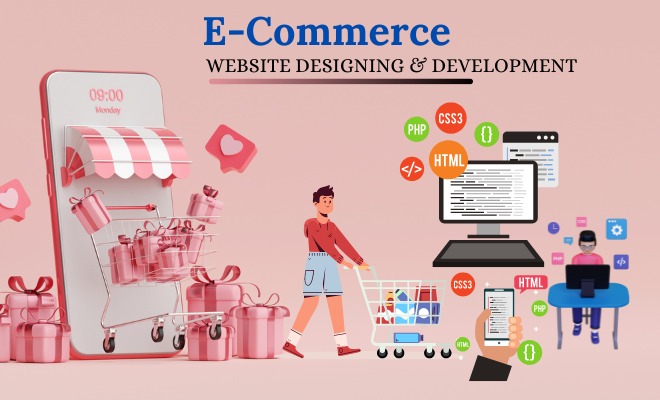E-commerce Website Designing Development Company

E-commerce Website Designing Development Company
E-commerce Website Designing and Development: Everything You Need to Know
E-commerce has become a crucial aspect of conducting business in the current digital era. Online purchasing is becoming increasingly popular; therefore, businesses must have a strong online presence to succeed. This is where designing and developing an e-commerce website comes in.
Planning and developing an e-commerce website includes building a website that enables businesses to sell their goods and services online. These websites have been made user-friendly, aesthetically pleasing, and simple to use. To simplify the purchasing process for clients, they frequently incorporate features like shopping carts, payment gateways, and inventory management systems.
How the Website Design and Development Process Works
The first step in designing and developing an e-commerce website is to comprehend the customer's target market and commercial objectives. This information creates a website design specific to the client's brand and showcases their USP. The website should have a user-friendly interface with clear calls to action to entice visitors to purchase.
The development phase starts after the design is accepted. This includes creating the backend systems to control inventory and orders, integrating payment gateways and shopping carts, and building the website. The website's development team will also ensure that it is responsive, mobile-friendly, and search engine optimized.
Testing Can Produce More Effective Results
The design and development of an e-commerce website must include testing. The website must be extensively tested to guarantee that it is operating properly and that there are no problems or issues. The website is prepared for launch once the testing phase is over.
After the website is launched, regular upkeep and changes are required to keep it practical and current. This entails maintaining the product inventory, keeping track of the website's functionality, and ensuring that security precautions are taken to safeguard client information.
Why Is E-commerce Design and Development Crucial: Reasons to Note
1. Increased sales: By making it simple for clients to find and buy products or services online, a well-designed and user-friendly e-commerce website can enhance sales. Businesses may attract and keep more customers by developing an intuitive and effective online buying experience, thereby increasing revenue.
2. Global audience: Since e-commerce websites are accessible from anywhere in the world, firms may market to people worldwide. This implies that companies can reach new markets and increase their consumer base outside their current geographic region.
3. Cost-effective: Setting up an e-commerce website is frequently less expensive than opening a physical store. This is so that firms can cut staffing and inventory management expenditures and avoid paying rent or other expenses related to a physical site.
4. Data tracking: E-commerce websites give businesses useful information on customer behaviour, including information on the most popular products, the average time visitors spend on the site, and the pages they visit. This information can be used to enhance the website and make data-driven decisions to maximise sales and consumer engagement.
5. Competitive advantage: An e-commerce website is becoming increasingly crucial for businesses in the current digital era. Businesses can get a competitive edge over rivals and position themselves as industry leaders by establishing a successful e-commerce website.
Designing an E-commerce Website: Steps to Follow
1. Identify your target audience: The first step in developing a website that appeals to your target audience is understanding who they are. Take into account elements like age, gender, location, hobbies, and purchasing tendencies. Use this knowledge to design a website that appeals to your target market.
2. Select a platform: Shopify, WooCommerce, and Magento are just a few examples of accessible e-commerce platforms. Choose a platform based on your research into them and your company's goals and budget.
3. Select a design theme: E-commerce platforms frequently provide a selection of design themes. Pick a theme that complements your brand and looks good.
4. Make your website's navigation clear: It should be simple to use and straightforward. Make it simple for customers to find what they're looking for by using a top-level navigation bar to categorize your goods or services and a search bar.
5. Optimize for mobile: As more and more consumers conduct their online shopping on mobile devices, it is imperative that your website be mobile-friendly. This entails making the website user-friendly on mobile devices and adopting a responsive design, which adapts to various screen sizes.
6. Utilize photographs of the highest calibre: photographs of the highest calibre are essential for presenting your goods and services. The advantages of high-quality photographs are that they demonstrate the products from various perspectives and take advantage of zoom features to let clients view the finer details.
7. Include customer testimonials: Including testimonials on your website helps enhance sales and establish confidence with visitors. Make use of a review platform that enables customer comments and ratings.
8. Make checkout simple: You should make the checkout process as simple as you can. To make it simple for customers to pay, use a one-page checkout procedure and offer a variety of payment methods.
9. Testing: After going live, test your website frequently to find any problems or potential improvements. Utilize analytical tools to behaviour and make data-driven decisions to continuously improve the website.
Common Challenges In the Process of Website Design and Development
Businesses may encounter a number of frequent difficulties during the website design and development process. The following are some of the major difficulties in developing and designing websites:
1. User experience: It can be difficult to design a user-friendly, intuitive website that satisfies the requirements of your target market. To learn what works best for your customers and to iteratively develop your website based on their input, it's critical to undertake user research and testing.
2. Management of website content: This can be a time-consuming and difficult task. For the website to remain current and relevant, it's crucial to have a content management system that enables simple updates and revisions as well as a defined content strategy.
3. Security: Websites are susceptible to security risks, including malware and cyber attempts. To safeguard your website and the information of your clients, it's crucial to have strong security measures in place, such as SSL certificates and frequent security upgrades.
4. Mobile optimization: As more and more people use their mobile devices to access the internet, it is essential to make your website mobile-friendly. It can be difficult to build a seamless and simple mobile experience because mobile devices have varied screen sizes and resolutions.
5. System integration: To handle tasks like payment processing and inventory management, many companies use a variety of platforms and systems. Making ensuring that these technologies are properly integrated with your website and that they operate in harmony might be difficult.
6. Search engine optimization: Because search algorithms are continuously changing, designing a website that is optimized for search engines can be difficult. The search engine rankings of your website should be continuously monitored and improved while implementing a clear SEO plan.
The Future Trends
Businesses should be aware of several upcoming trends in the design and development of e-commerce websites as technology continues to advance. Here are a few major trends to keep an eye on:
1. Mobile commerce: Mobile optimization is vital since more and more consumers are making purchases using their mobile devices. Future mobile commerce capabilities, including mobile payments and mobile-friendly checkout procedures, are something we can anticipate seeing.
2. Artificial intelligence: Chatbots that offer customer service are just one application of artificial intelligence in e-commerce. We may anticipate seeing more sophisticated AI solutions in the future that assist companies in customizing the shopping experience and making wiser decisions based on customer data.
3. Voice commerce: As voice assistants like Amazon Alexa and Google Assistant gain popularity, speech shopping is becoming a significant e-commerce trend. We can anticipate more companies using voice commerce in their websites and mobile applications in the future.
4. Augmented reality: Customers can digitally "try on" things before making a purchase, thanks to augmented reality technology. Some merchants are currently utilizing this technology, and more companies will likely do so in the future.
5. Personalization: As customers demand a more specialized purchasing experience, personalization is becoming more significant in e-commerce. Future personalization capabilities should include targeted marketing efforts and individualized product recommendations, among other things.
6. Integration of social media: For e-commerce sales, social media sites are playing a bigger role. We may anticipate more companies incorporating social media functions into their websites and mobile applications in the future, such as social media-based checkout procedures and product suggestions.
Final Words
Designing and developing an effective e-commerce website is essential to operating a profitable online business. Businesses may increase revenue, foster brand loyalty, and draw and keep customers with the aid of an attractive and user-friendly website.
To remain competitive in the modern digital marketplace, it's critical to stay up to date on the most recent e-commerce innovations, like mobile optimization, artificial intelligence, voice commerce, augmented reality, personalization, and social media integration. Businesses can develop efficient and interesting e-commerce experiences that promote growth and engagement by adhering to the suggestions given in this article.

 Best Digital Market…
Best Digital Market…
 Digital Marketing A…
Digital Marketing A…
Leave a Reply